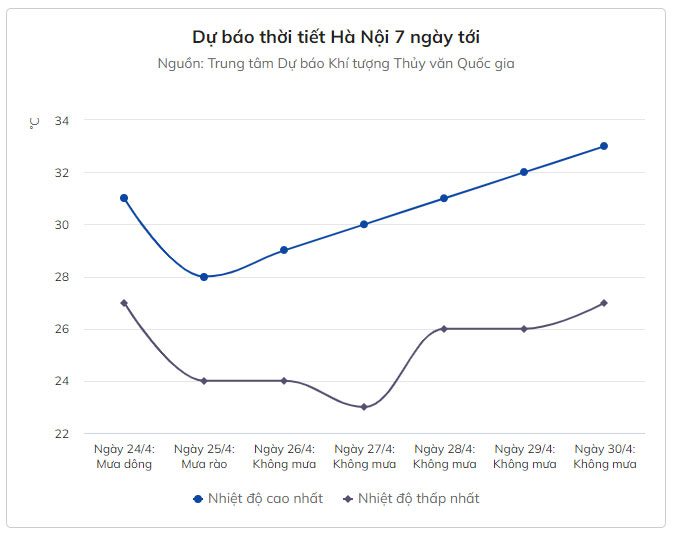The North will experience cooler weather with thunderstorms for two days next week before entering a prolonged hot spell that may last through the April 30-May 1 holiday. Meanwhile, the South will continue to endure extended periods of heat.
The National Center for Hydro-Meteorological Forecasting reported that on April 24, the North will shift to thunderstorms and gradually cool down after many days of hot weather. The weather will be overcast, with localized heavy rain amounts generally ranging from 10-30 mm, and in some places exceeding 50 mm.
Around the night of April 24, a cold air mass will affect the mountainous regions of Northern Vietnam and gradually extend to the Northeast and North Central regions.
At this time, the northeast wind on land will strengthen to level 2-3, while coastal areas will see winds of level 3-4.
On April 25-26, the weather in the Northeast and North Central regions will become cooler. During this period, the lowest temperatures in the plains will generally be 20-23 degrees Celsius, with some mountainous areas falling below 19 degrees Celsius at night. During the day, the highest temperatures will reach around 26 degrees Celsius, providing a pleasant atmosphere.
This is the final cold air outbreak of the season affecting the North during the winter-spring period of 2022-2023. After this, the region will officially enter the hot season of summer.

Notably, due to the influence of the eastern cold air, from the afternoon of April 24 until the end of April 25, many areas in the North will experience thunderstorms. Some places may see heavy rain with daily amounts generally ranging from 20-40 mm, and in some areas exceeding 70 mm.
In contrast, thunderstorms will occur later in Thanh Hoá to Thừa Thiên-Huế. This area will experience rain on April 25-26, with rainfall amounts between 10-30 mm per day, and some places exceeding 50 mm.
Experts warn that thunderstorms may be accompanied by whirlwinds, lightning, hail, and strong gusts of wind, which could affect agricultural production, topple trees, damage houses, and impact transportation infrastructure.
Additionally, localized heavy rain may cause flooding in low-lying areas. Strong winds and high waves at sea could affect the operations of boats and other activities.
Accuweather predicts that Hanoi and the northern delta provinces will continue to experience thunderstorms until the end of April 25. After that, temperatures will gradually increase and return to a state of continuous heat from April 26 to May 3.
It is likely that Northern Vietnam will celebrate the April 30-May 1 holiday with dry weather, overcast skies, and no heat. Meanwhile, Central Vietnam may experience some heat, but not excessively during this period.
Simultaneously, the heat in Southern Vietnam is expected to persist through the holiday. Next week, this region will remain in a peak heat phase with maximum temperatures generally ranging from 35-37 degrees Celsius, with some areas exceeding 37 degrees Celsius.
The meteorological agency advises that with low humidity in the air, residents should be cautious of the risk of fires and explosions in residential areas due to increased electricity demand; they should also be aware of the risk of forest fires.
Moreover, the heat can lead to dehydration, exhaustion, and heatstroke due to prolonged exposure to high temperatures.


















































